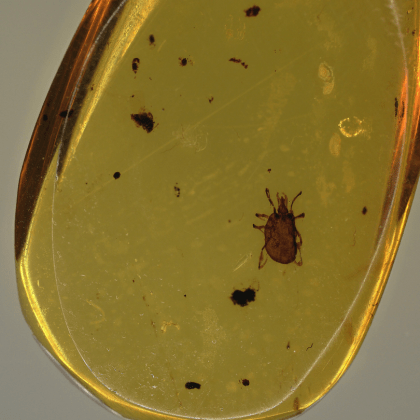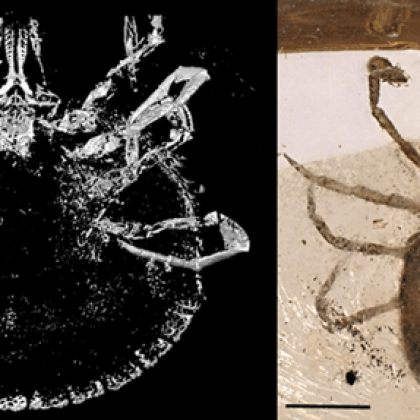DEAD TICK CLADE WALKING
The latest Paper of the Month for Parasitology is Nuttalliellidae in Burmese amber: implications for tick evolution and this paper is available open access.

Before 1935, ticks were composed of the hard (Ixodidae) and soft (Argasidae) tick families. In 1931, Gerald Bedford described a peculiar tick species named Nuttalliella namaqua, which he considered a missing link between the two families, since it shared characteristics with both families. It had terminal mouthparts like hard ticks, a region that looked like the hard tick scutum, but was non-sclerotized (called a pseudoscutum), and an anterior anal groove as seen in the hard tick genus Ixodes. However, it also had a soft leathery integument seen in soft ticks and a unique feature described as ball-and-socket joints not found in any arthropod lineage. A few years later two authors, Paul Schulze and Henrique Aragão, independently raised the same family (Nuttalliellidae), which remained a family of one species (monotypic) for the next eighty-nine years. This species presented many enigmatic puzzles. It is secretive and difficult to find in nature and for many years no molecular sequence information was available. Since the male was never collected some considered it parthenogenic (females can lay viable eggs without mating). The feeding mode and how this species deals with excess water from the blood meal was not known. In 2011/2012 the enigma was cracked with new collections and it was shown that N. namaqua group basal to the hard and soft ticks based on nuclear and mitochondrial genome phylogenetic analysis; that males exist; that different from hard ticks, this species shows soft tick-like fast feeding behavior in females; but unlike hard or soft ticks, secrete excess water via the anal pore and not the salivary glands (hard ticks), or coxal organs (soft ticks). This species also had a unique Afrotropical distribution, suggesting a possible origin for ticks in Gondwanaland. Its monotypic status suggested that it is a “dead clade walking”, ie. a lineage that survived a mass extinction event but never recovered.

In 2017, a new tick family (Deinocrotonidae) was described from Burmese amber fossils dated 100 million years ago. This family showed close affinities to N. namaqua, sharing a pseudoscutum in males and females, as well as the leathery integument, although it lacked definite ball-and-socket joints. Even so, the artistic depiction of feeding male and female ticks looked almost to a hair like the photos published for male and engorged female N. namaqua, raising interesting possibilities regarding their true affinities. Recently, five Nuttalliella and two Deinocroton fossils were described from Burmese amber, in addition to a new genus, Legionaris. Microtomography of extant and fossil specimens indicated that the “ball-and-socket” joints previously described for N. namaqua are not true ball-and-socket joints but show articulation deep within the proximal segments or coxae, similar to the Deinocroton and Legionaris. This removed any morphological distinction that would warrant different family status, leading to combination of the three genera in the Nuttalliellidae. This suggests that the Nuttalliellidae is indeed a “dead clade walking”, with the majority of its members extinct. Molecular dating place the divergence of the Nuttalliellidae from the hard and soft ticks somewhere in the Late Permian, suggesting that this family survived at least three major mass extinction events. The last mass extinction at the end-Cretaceous may have finally decimated this family before the Burma terrane accreted to Asia and prevented dispersal of this family into the Asian continent. Even so, the presence in Burmese amber suggest a much wider distribution of this family than the current Afrotropic distribution, including Antarctica and Australia. There is therefore a possibility that renewed searches for this secretive family may uncover new species outside Africa.
The paper Nuttalliellidae in Burmese amber: implications for tick evolution by Lidia Chitimia-Dobler, Stephan Handschuh, Jason A. Dunlop, Ronel Pienaar and Ben J. Mans, published in Parasitology and this paper is available open access..






